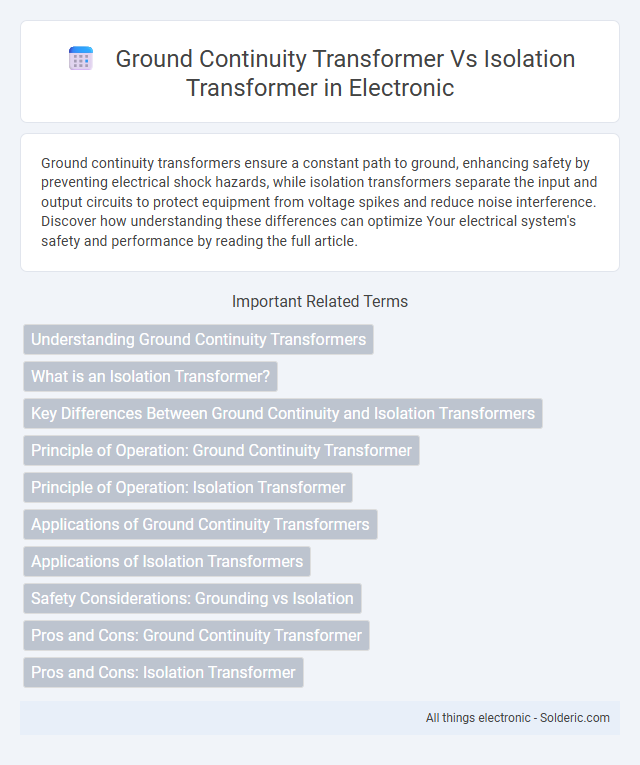Ground continuity transformers ensure a constant path to ground, enhancing safety by preventing electrical shock hazards, while isolation transformers separate the input and output circuits to protect equipment from voltage spikes and reduce noise interference. Discover how understanding these differences can optimize Your electrical system's safety and performance by reading the full article.
Comparison Table
| Feature | Ground Continuity Transformer | Isolation Transformer |
|---|---|---|
| Purpose | Maintains continuous grounding in electrical systems | Provides galvanic isolation between input and output |
| Function | Ensures uninterrupted ground path for safety | Prevents direct electrical connection to reduce shock risk and noise |
| Safety | Enhances grounding system reliability | Increases equipment and user safety by isolating circuits |
| Application | Used in datasets requiring continuous ground monitoring | Common in medical, industrial, and sensitive electronic equipment |
| Output | Maintains same ground reference as input | Separate ground from input, often with floating output |
| Protection | Protects against ground interruptions | Protects against electrical noise and transient surges |
Understanding Ground Continuity Transformers
Ground continuity transformers provide a continuous ground path to ensure electrical safety by monitoring and protecting against ground faults. Unlike isolation transformers, which electrically separate input and output circuits to prevent noise and interference, ground continuity transformers maintain a direct grounding connection to protect equipment and personnel. Understanding your specific grounding requirements helps determine whether a ground continuity transformer or an isolation transformer is the optimal choice.
What is an Isolation Transformer?
An isolation transformer is a device designed to isolate the electrical equipment from the power source, enhancing safety by preventing direct electrical connection and minimizing electrical noise interference. It features equal primary and secondary windings that provide voltage transformation without a direct conductive path, effectively reducing the risk of electric shock and protecting sensitive electronics. Unlike ground continuity transformers, isolation transformers focus on galvanic isolation to improve system integrity and protect against electrical faults.
Key Differences Between Ground Continuity and Isolation Transformers
Ground continuity transformers maintain a direct connection between the load and the grounding system, ensuring safe fault current paths for equipment protection, whereas isolation transformers provide electrical separation between the primary and secondary circuits, eliminating direct conductive paths and enhancing safety by reducing electrical noise and transient voltages. Ground continuity transformers are primarily used in applications requiring continuous grounding for fault detection, while isolation transformers are designed to protect sensitive electronic equipment by isolating the power source. The key difference lies in their function: ground continuity transformers prioritize grounding integrity, and isolation transformers focus on electrical isolation and noise reduction.
Principle of Operation: Ground Continuity Transformer
A Ground Continuity Transformer operates by maintaining a continuous electrical path to the ground, ensuring safety and preventing electrical shocks during fault conditions. It monitors the integrity of grounding connections by detecting discrepancies in current flow and immediately signals interruptions or breaks in the ground path. This principle enhances protection in electrical systems by guaranteeing a reliable earth reference throughout the network.
Principle of Operation: Isolation Transformer
Isolation transformers operate by magnetically coupling the primary and secondary windings without direct electrical connection, effectively isolating the secondary circuit from the primary power source. This design minimizes noise, reduces electrical shock hazards, and provides protection against ground faults by interrupting direct current paths. You benefit from enhanced safety and improved signal integrity in sensitive electronic applications through this principle of operation.
Applications of Ground Continuity Transformers
Ground continuity transformers are primarily used in electrical safety applications to ensure a continuous grounding path, preventing fault currents and enhancing personnel protection in industrial and commercial settings. These transformers detect ground faults by maintaining a reference ground, making them essential for monitoring systems in manufacturing plants, data centers, and healthcare facilities where reliable grounding is critical. Your electrical system benefits from improved fault detection and reduced risk of equipment damage when using ground continuity transformers in these environments.
Applications of Isolation Transformers
Isolation transformers are widely used in medical equipment to provide patient safety by preventing electrical shock through galvanic isolation. They are essential in sensitive electronic testing environments to reduce electrical noise and protect instruments from voltage spikes. Industrial applications include powering control circuits and machinery to isolate them from the main power source, enhancing operational reliability and safety.
Safety Considerations: Grounding vs Isolation
Ground continuity transformers ensure safety by maintaining a continuous ground path, preventing electric shock and equipment damage through reliable grounding. Isolation transformers enhance safety by electrically separating the input from the output, reducing the risk of ground faults and electrical noise interference. Choosing between these transformers depends on your specific safety requirements for grounding integrity versus electrical isolation.
Pros and Cons: Ground Continuity Transformer
Ground continuity transformers provide a reliable path to ground, enhancing electrical safety by preventing potential shock hazards and equipment damage. However, they can introduce slight voltage drops and may require regular maintenance to ensure the grounding connection remains effective. Your choice depends on prioritizing safety and grounding stability over isolation from noise or transient voltages.
Pros and Cons: Isolation Transformer
Isolation transformers provide superior electrical isolation by separating the primary and secondary windings, reducing the risk of electric shock and minimizing noise interference in sensitive equipment. Their main advantage lies in enhancing safety and improving signal quality in medical, industrial, and audio applications, but they tend to be heavier, more expensive, and less efficient compared to ground continuity transformers. Your choice depends on whether electrical isolation and noise reduction are critical, despite the potentially higher cost and size.
ground continuity transformer vs isolation transformer Infographic

 solderic.com
solderic.com